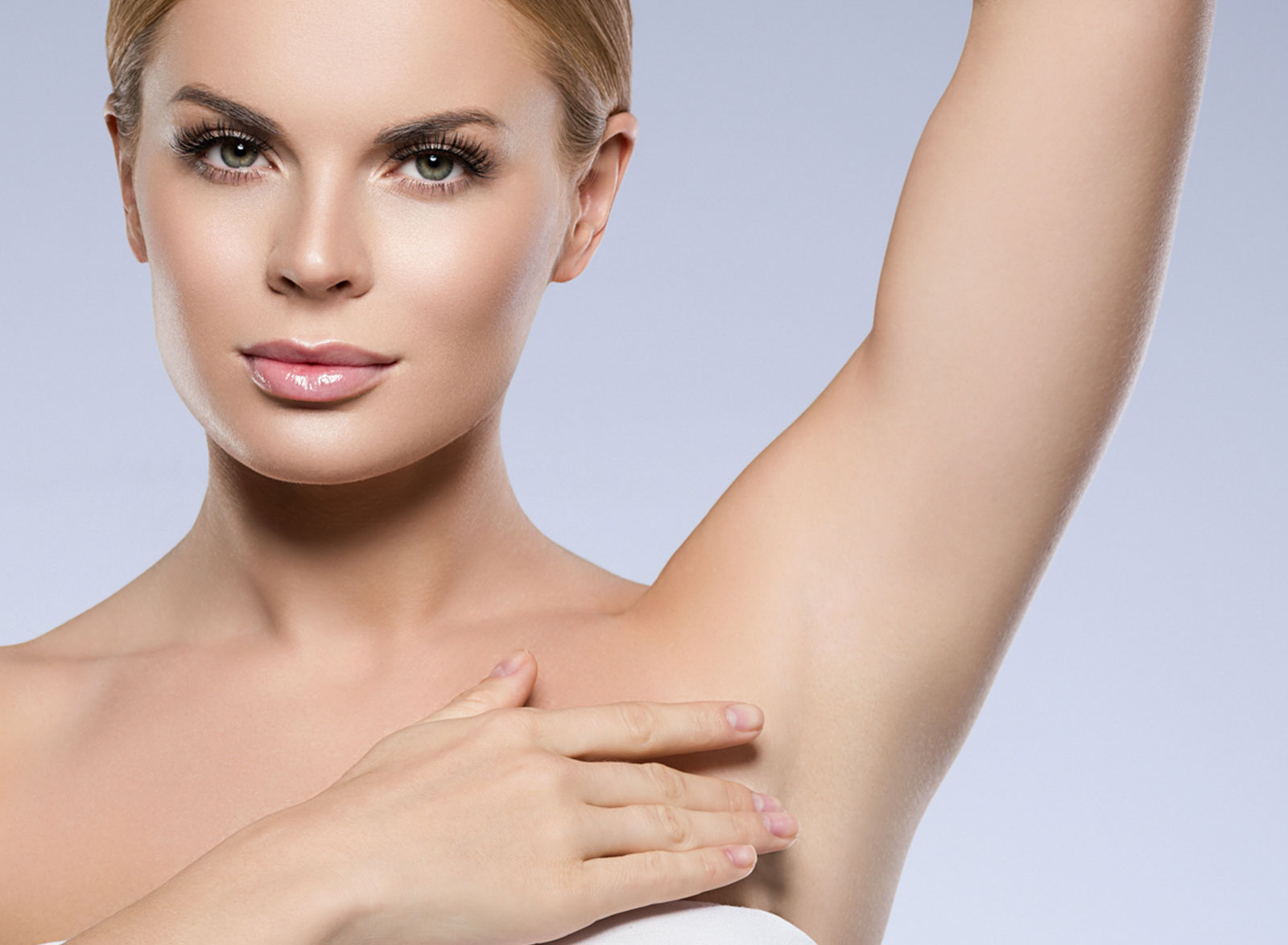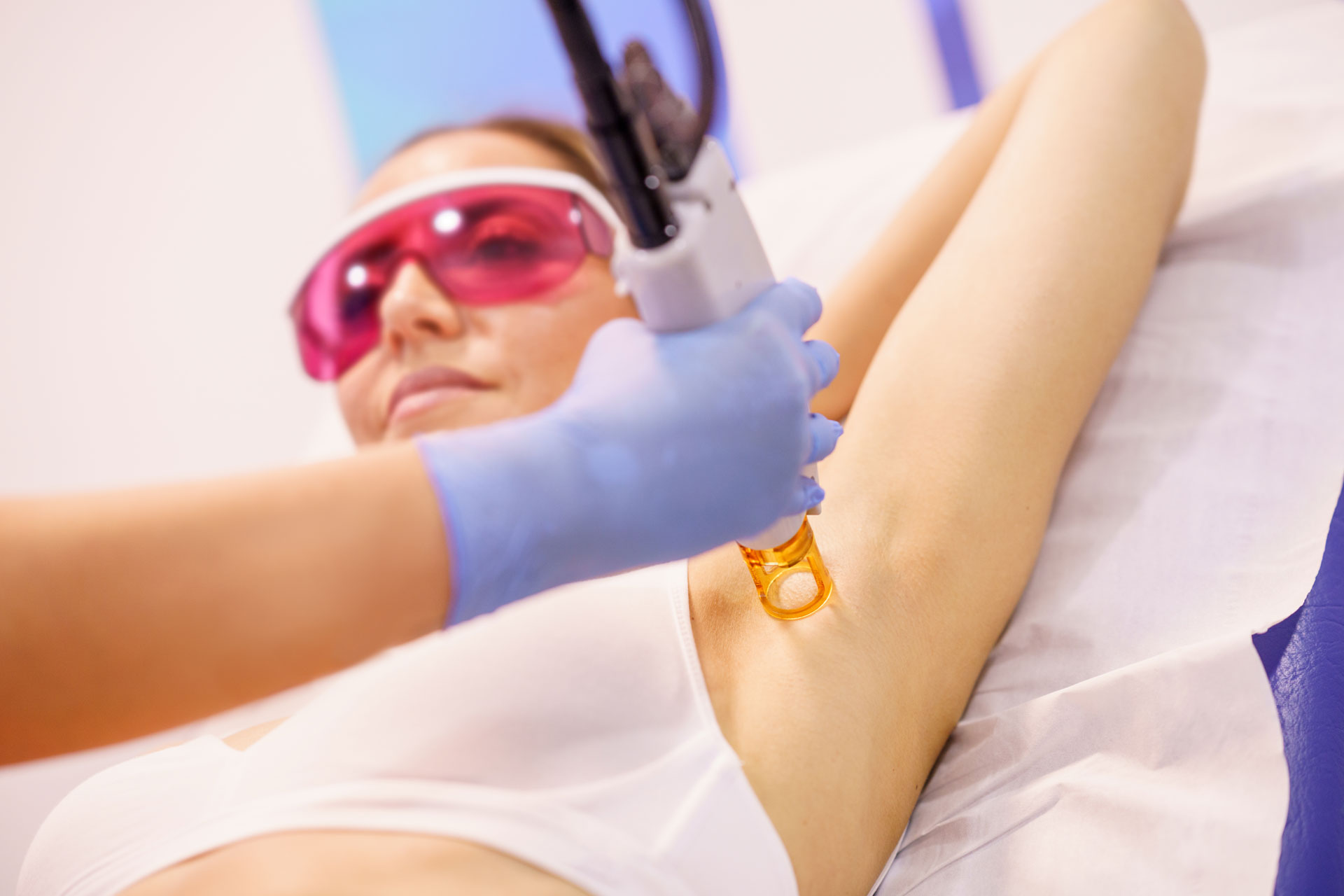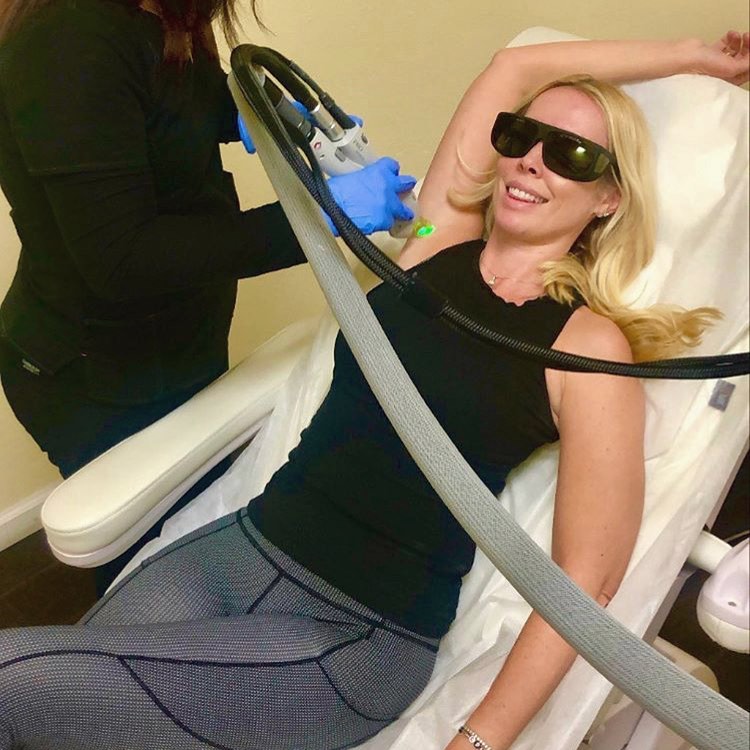Exfoliating after Laser Hair Removal is essential for achieving the best results and maintaining smooth, healthy skin. At Spoiled Laser, we provide expert guidance on how to properly care for your skin post-treatment to enhance your experience.
After undergoing Laser Hair Removal, it’s important to wait at least 48 hours before exfoliating. This allows your skin time to heal and reduces the risk of irritation. When you’re ready to exfoliate, follow these steps:
Choose a Gentle Exfoliator: Use a mild exfoliating scrub or a soft, natural exfoliating cloth. Avoid harsh scrubs with large, abrasive particles.
Be Gentle: Apply the exfoliator with gentle, circular motions. Avoid vigorous rubbing, which can irritate the treated area.
Moisturize: After exfoliating, apply a soothing, hydrating moisturizer to keep your skin soft and supple.
Sun Protection: Use a broad-spectrum sunscreen to protect your skin from UV rays, as it can be more sensitive post-treatment.
Regular exfoliation helps remove dead skin cells, allowing hair to shed more easily and preventing ingrown hairs. For personalized advice and to learn more about our Laser Hair Removal services, call Spoiled Laser at 702-228-5171. Let us help you achieve the smooth, beautiful skin you desire with our expert care and advanced treatments.
If you have recently undergone laser hair removal and are now looking for effective ways to care for your skin post-treatment, you have come to the right place. Welcome to “Post-Laser Hair Removal Care: Your Guide to Effective Waxing.” Spoiled Laser is your go-to destination for all your beauty transformation needs, offering a wide range of premium services such as laser hair removal, skin bleaching, facial treatments, body contouring, and more. In this article, we will explore the essential steps and tips to ensure proper aftercare and maintenance for your skin, leaving you with long-lasting, smooth results.
General tips for post-laser hair removal care
After undergoing laser hair removal treatment, it is crucial to take proper care of the treated area to ensure optimal results and minimize potential side effects. Here are some general tips to keep in mind for your post-laser hair removal care routine:
Keep the treated area clean
Maintaining cleanliness is essential to prevent any infections or complications. Gently cleanse the treated area with a gentle cleanser or mild soap and lukewarm water. Avoid using harsh or scented cleansers, as they can irritate the skin.
Avoid excessive heat
Following laser hair removal treatment, it is important to avoid heat sources that can exacerbate redness and skin sensitivity. Refrain from taking hot showers, using saunas, or indulging in activities that can cause excessive sweating.
Avoid direct sunlight
Direct exposure to sunlight can lead to skin damage and pigmentation issues. Shield the treated area from the sun by wearing protective clothing such as wide-brimmed hats and long-sleeved shirts. Additionally, apply a broad-spectrum sunscreen with a high SPF to protect against harmful UV rays.
Do not exfoliate immediately
While exfoliation is a crucial part of any skincare routine, it is vital to avoid Exfoliating the Treated Area immediately after Laser Hair Removal. Wait for a few days before gently exfoliating to avoid irritation or damage to the sensitive skin.
Moisturize regularly
Keeping the treated area well-moisturized is key to maintaining supple and healthy skin. Apply a gentle moisturizer or hydrating cream to the treated area regularly, preferably after cleansing. Look for products that are fragrance-free and suitable for sensitive skin.
Avoid using harsh chemicals on the skin
During the post-laser hair removal period, it is crucial to avoid using any harsh chemicals or irritants on the treated area. Opt for mild and gentle skincare products that are specifically formulated for sensitive skin.
Avoid tight clothing
Avoid wearing tight clothing that may rub against the treated area and cause irritation or discomfort. Opt for loose-fitting and breathable fabrics to allow the skin to heal effectively.
Stay hydrated
Proper hydration plays a vital role in maintaining healthy skin. Drink an adequate amount of water daily to keep your body hydrated, which will promote overall skin health and aid in the healing process.
Minimize physical activities
Engaging in strenuous physical activities immediately after laser hair removal can increase the risk of complications and discomfort. It is advisable to avoid activities such as heavy lifting, vigorous exercise, or activities that may cause excessive sweating for a few days after treatment.
Follow the post-treatment instructions
Every individual is unique, and the specific post-treatment instructions provided by your dermatologist or laser technician may vary. It is crucial to carefully follow their instructions to ensure optimal outcomes and minimize the risk of complications.
Get Your Free Consultation Today
Proper cleansing techniques
While cleansing the treated area may seem straightforward, it is essential to follow specific techniques to ensure optimal results and minimize any potential damage to the skin. Here are the proper cleansing techniques to follow after laser hair removal:
Use gentle cleansers
Choosing the right cleanser is crucial for maintaining the skin’s integrity and pH balance. Opt for a gentle cleanser or mild soap that is specifically formulated for sensitive skin. Look for products that do not contain harsh chemicals, fragrances, or irritants that can potentially irritate the skin.
Avoid hot water
Hot water can exacerbate the sensitivity of the treated area, leading to increased redness or discomfort. Stick to lukewarm water when cleansing the area to prevent any adverse reactions.
Pat dry the treated area
After cleansing, be sure to pat dry the treated area gently with a soft, clean towel. Avoid rubbing or scrubbing the skin vigorously, as it can cause irritation or damage to the delicate skin.
Avoid rubbing or scratching the skin
It is natural to feel slight itching or discomfort after laser hair removal treatment. However, resist the urge to scratch or rub the skin, as it can lead to further irritation or potential complications. If necessary, lightly tap or pat the skin to alleviate any itching sensation.
Cleanse in a circular motion
When cleansing the treated area, use a circular motion to ensure thorough yet gentle cleansing. This technique helps remove any residual debris or skincare products without putting excessive pressure on the skin.
Recommended skincare products for post-laser hair removal care
In addition to proper cleansing techniques, incorporating the right skincare products into your post-laser hair removal care routine can aid in the healing process and promote healthy-looking skin. Here are some recommended skincare products to consider:
Aloe vera gel
Aloe vera gel is renowned for its soothing and cooling properties, making it an excellent choice for post-laser hair removal care. Apply a thin layer of pure aloe vera gel to the treated area to alleviate redness, inflammation, and discomfort.
Hydrating creams
Choose a hydrating cream formulated specifically for post-laser hair removal care to replenish moisture and promote skin healing. Look for creams that contain ingredients like hyaluronic acid, glycerin, or ceramides to provide intense hydration and improve the skin’s barrier function.
Vitamin E oil
Vitamin E oil is known for its antioxidant properties and can assist in soothing irritated or inflamed skin. Gently apply a small amount of vitamin E oil to the treated area to help with skin healing and reduce redness.
Calendula ointment
Calendula ointment, derived from marigold flowers, has anti-inflammatory properties and can help soothe and calm the skin after laser hair removal. Apply a thin layer of calendula ointment to the treated area to promote healing and alleviate any discomfort.
Tea tree oil
Tea tree oil possesses natural antiseptic and anti-inflammatory properties, making it beneficial for post-laser hair removal care. Dilute tea tree oil with a carrier oil, such as coconut or jojoba oil, and apply it sparingly to the treated area to prevent any potential infections.
Witch hazel
Witch hazel is a natural astringent that can help alleviate redness and inflammation after laser hair removal treatment. Apply a small amount of witch hazel to a cotton pad and gently dab it onto the treated area to soothe the skin.
Managing discomfort and redness
While laser hair removal is generally well-tolerated, some individuals may experience mild discomfort and redness following the treatment. Here are some strategies to manage these post-treatment symptoms:
Apply cold compresses
To alleviate discomfort and reduce redness, apply cold compresses to the treated area. Use a clean cloth soaked in cold water or cool gel packs. The cold temperature can help constrict blood vessels, reduce inflammation, and provide relief.
Avoid hot showers or baths
Avoid exposing the treated area to hot water, as it can exacerbate redness and increase discomfort. Opt for lukewarm or cool showers and baths instead.
Avoid touching or picking at the treated area
To prevent infection or further irritation, avoid touching or picking at the treated area. Keep in mind that the skin is sensitive after laser hair removal and needs time to heal properly.
Take over-the-counter pain relievers if necessary
If you experience mild pain or discomfort after laser hair removal, you may consider taking over-the-counter pain relievers such as acetaminophen or ibuprofen. However, always consult with your healthcare provider or dermatologist before taking any medication.
Consult with your dermatologist if severe discomfort persists
If you experience severe or prolonged discomfort, redness, or any other concerning symptoms, it is essential to consult with your dermatologist or a medical professional. They can assess your condition and provide appropriate treatment or advice.
Sun protection after laser hair removal
After laser hair removal treatment, the treated area becomes more susceptible to sun damage. To protect your skin from harmful UV rays and reduce the risk of complications, take the following sun protection measures:
Apply broad-spectrum sunscreen
Apply a broad-spectrum sunscreen with a high SPF (sun protection factor) to the treated area whenever you go outdoors. Choose a sunscreen that provides protection against both UVA and UVB rays. Reapply sunscreen every few hours, especially if you perspire heavily or come into contact with water.
Wear protective clothing
In addition to sunscreen, wear protective clothing to shield the treated area from direct sun exposure. Opt for wide-brimmed hats, long-sleeved shirts, and pants that cover the treated skin. Consider wearing clothing made from UPF (ultraviolet protection factor) fabric for added sun protection.
Seek shade during peak sun hours
To minimize sun exposure, seek shade or stay indoors during the peak sun hours, typically between 10 am and 4 pm. This is when the sun’s rays are the strongest and can cause the most damage to the skin.
Reapply sunscreen every few hours
Regardless of the SPF or water resistance of your sunscreen, it is crucial to reapply it every few hours. Continuous sun exposure can weaken sunscreen effectiveness, so reapplication is necessary to maintain optimal protection.
Tips for avoiding ingrown hairs after laser hair removal
While laser hair removal significantly reduces the occurrence of ingrown hairs, they can still happen occasionally. Follow these tips to minimize the risk of ingrown hairs after treatment:
Exfoliate regularly
Regular exfoliation helps remove dead skin cells and prevent the buildup of debris that can lead to ingrown hairs. Use a gentle exfoliating scrub or a loofah to gently exfoliate the treated area. However, avoid exfoliating immediately after treatment and wait for a few days before starting your exfoliation routine.
Avoid tight clothing
Wearing tight clothing can increase friction and contribute to the formation of ingrown hairs. Opt for loose-fitting clothing that allows the skin to breathe and minimizes irritation.
Moisturize the treated area
Properly moisturized skin is less prone to dryness and flakiness, which can contribute to ingrown hairs. After laser hair removal, moisturize the treated area with a soothing lotion or cream to keep the skin hydrated and supple.
Use topical treatments for prevention
Topical treatments containing ingredients such as salicylic acid, glycolic acid, or retinoids can help prevent ingrown hairs by keeping the skin exfoliated and reducing inflammation. Consult with your dermatologist or skincare professional to find the most suitable topical treatment for your needs.
Avoid excessive shaving or waxing
To prevent ingrown hairs, avoid excessive shaving or waxing between laser hair removal sessions. Allow your hair to grow to the recommended length before undergoing subsequent treatments.
Managing potential side effects
Although laser hair removal is a safe and effective procedure, like any medical treatment, it may carry some potential side effects. It is essential to be aware of these side effects and know how to manage them. Here are some common side effects and how to address them:
Swelling and redness
Mild swelling and redness are common immediately following laser hair removal treatment. Apply a cold compress or ice pack to the treated area to reduce swelling and soothe the skin. Avoid exposing the treated area to excessive heat, direct sunlight, or any activities that may exacerbate redness.
Blistering and crusting
In rare cases, blistering and crusting may occur after laser hair removal treatment. If blisters or crusts develop, do not pick or scratch them, as it can lead to infection or scarring. Keep the treated area clean, follow any specific aftercare instructions provided by your dermatologist, and consult with them if the symptoms worsen.
Hyperpigmentation
Hyperpigmentation, characterized by darkening of the skin, may occur as a temporary side effect of laser hair removal. Avoid sun exposure and apply broad-spectrum sunscreen to minimize the risk of hyperpigmentation. In some cases, your dermatologist may recommend topical treatments or skincare products that can help fade hyperpigmentation.
Hypopigmentation
Less commonly, laser hair removal may cause hypopigmentation, which is the lightening of the skin. If you notice areas of lighter skin, avoid sun exposure and protect the treated area with sunscreen and protective clothing. In some cases, hypopigmentation may resolve on its own over time, but consult with your dermatologist for further guidance.
Skin infection
Although rare, there is a risk of skin infection after laser hair removal. If you notice signs of infection such as increased redness, warmth, swelling, or pus, consult with your dermatologist or healthcare professional. They may prescribe antibiotics or recommend appropriate treatment to resolve the infection.
Scarring
While laser hair removal typically does not cause scarring, there is a minimal risk, especially if not performed by a trained professional or if proper aftercare is not followed. If you notice any signs of scarring, consult with your dermatologist for evaluation and management options.
Consult with your dermatologist if any side effects occur
If you experience any severe or persistent side effects after laser hair removal treatment, it is essential to seek professional help. Consult with your dermatologist or healthcare professional for an accurate assessment and appropriate management of any side effects.
Avoiding common mistakes in post-laser hair removal care
To ensure a smooth and effective post-laser hair removal care routine, it is important to avoid certain common mistakes. Here are some mistakes to steer clear of:
Skipping sunscreen
One of the most common mistakes is failing to apply sunscreen regularly to the treated area. Sun exposure can lead to complications and compromise the results of your treatment. Make sunscreen application a part of your daily routine to protect your skin from harmful UV rays.
Picking or scratching the treated area
Resist the urge to pick or scratch the treated area, as it can lead to infections, scarring, or delayed healing. Be gentle with your skin to allow it to heal properly and minimize the risk of complications.
Using harsh exfoliators
While exfoliation is beneficial for keeping the skin clean and preventing ingrown hairs, it is important to use gentle exfoliators specifically formulated for sensitive skin. Avoid using harsh or abrasive exfoliators immediately after laser hair removal, as they can irritate or damage the treated area.
Applying irritants or fragrances
After laser hair removal, it is important to choose skincare products that are free of irritants, fragrances, and unnecessary chemicals. These ingredients can potentially irritate the sensitive skin and delay the healing process.
Not following the recommended aftercare routine
Each individual may have different post-treatment care instructions provided by their dermatologist or laser technician. It is crucial to follow these instructions diligently to achieve optimal results and minimize potential side effects.
Delaying seeking professional advice
If you experience any concerning or persistent symptoms after laser hair removal treatment, do not delay seeking professional advice. Your dermatologist or healthcare professional can provide the appropriate guidance and intervention to address your concerns and ensure a successful treatment outcome.
Alternative hair removal methods during the post-laser period
While laser hair removal provides long-term reduction in hair growth, it may not eliminate all unwanted hairs permanently. During the post-laser period, you may explore alternative hair removal methods to manage any remaining hair growth. Here are some options for hair removal:
Shaving
Shaving is a quick and convenient method to remove unwanted hair. However, it does not remove the hair from the root and may require frequent maintenance. Use a clean, sharp razor and apply a gentle shaving cream or gel to minimize irritation.
Depilatory creams
Depilatory creams work by dissolving the hair just below the surface of the skin. These creams contain chemicals that break down the hair, allowing it to be wiped away. Follow the instructions carefully and perform a patch test before applying the cream to larger areas to avoid any adverse reactions.
Threading
Threading involves using a thin thread to remove individual hairs. This method is commonly used for shaping eyebrows but can also be used for other facial areas. Seek a trained professional to perform threading to ensure optimal results and minimize the risk of complications.
Tweezing
Tweezing is a manual hair removal method that involves plucking hairs individually using tweezers. This method is suitable for removing isolated hairs but may be time-consuming for larger areas. Be sure to disinfect the tweezers before use to reduce the risk of infection.
Epilators
Epilators are electronic devices that use multiple rotating tweezers to remove hair from the root. They are similar to tweezing but can cover larger areas more efficiently. Ensure that you read and follow the instructions carefully to avoid any discomfort or skin irritation.
When to seek professional help
While most individuals find laser hair removal to be a safe and effective treatment, it is essential to be aware of when to seek professional help. Here are some situations where you should consult with a dermatologist or healthcare professional:
Persistent pain or discomfort
Mild discomfort and sensitivity are normal immediately after laser hair removal treatment. However, if you experience persistent or increasing pain, it is important to seek professional evaluation to rule out any complications or underlying issues.
Severe swelling or redness
While some swelling and redness is expected after laser hair removal, severe or worsening symptoms may indicate an adverse reaction or infection. Consult with a dermatologist to assess the severity and determine the appropriate course of action.
Signs of infection
If you notice signs of infection such as increasing redness, warmth, swelling, or the development of pus or discharge, it is crucial to seek immediate medical attention. Infections can lead to complications if left untreated.
Unusual changes in skin texture or color
If you observe any unusual changes in the texture or color of the treated area, such as significant roughness, dryness, or discoloration, consult with your dermatologist for assessment and guidance.
Unresolved side effects
While laser hair removal side effects are generally temporary and resolve on their own, if you experience persistent or worsening side effects such as blistering, crusting, or scarring, it is essential to consult with a dermatologist for evaluation and treatment options.
In conclusion, proper post-laser hair removal care is crucial to achieve optimal results and minimize potential side effects. By following general care tips, adopting proper cleansing techniques, using recommended skincare products, and managing discomfort and redness effectively, you can ensure a smooth recovery process. Remember to protect your skin from the sun, follow guidelines for avoiding ingrown hairs, stay vigilant for potential side effects, and avoid common mistakes. If you are considering alternative hair removal methods during the post-laser period, be sure to follow proper techniques and seek professional advice when needed. By adhering to these guidelines and seeking professional help when necessary, you can maintain healthy and smooth skin after laser hair removal treatment.




